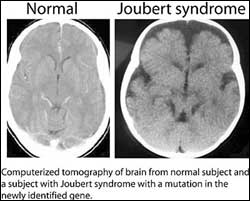Gene for Joubert syndrom with excessive brain folds discovered by UCSD researchers and Harvard team

Researchers at the University of California, San Diego (UCSD) School of Medicine have discovered the gene for a form of Joubert Syndrome, a condition present before birth that affects an area of the brain controlling balance and coordination in about 1 in 10,000 individuals. Their study, published in the November 2004 issue of the American Journal of Human Genetics*, pointed to mutations in a gene called AHI1 that lead to the production of a protein the scientists named Jouberin.
Separate research by a team from Harvard Medical School concurrently identified the same gene in a paper published in the November 2004 issue of the journal Nature Genetics.** Both the UCSD and Harvard studies were published online prior to the print publications in November.
The AHI1 gene mutation is responsible for a form of Joubert Syndrome manifested by absence of part of the cerebellum, the part of the brain controlling balance, and by excessive folding in the cerebral cortex, the part of the brain controlling consciousness and thought. The results from both UCSD and Harvard involved a gene-by-gene search of chromosome 6 DNA from three families studied by UCSD and three separate families studied by Harvard. Researchers believe the disorder linked to chromosome 6 is the most common of the three known forms of Joubert Syndrome.
“This is a tremendously exciting finding because it is the first genetic defect clearly associated with this condition. Although Joubert Syndrome is relatively rare, we think that the genes causing this condition are going to underlie more common childhood brain and behavioral abnormalities, such as autism, mental retardation, and poor coordination” said the UCSD paper’s senior author, Joseph Gleeson, M.D., assistant professor of neurosciences at UCSD and Children’s Hospital San Diego.
This identification caps a five-year hunt for the first gene for Joubert syndrome. The Gleeson team initially recruited families in the U.S., but after initial attempts, shifted focus to families in the Middle East, where inbreeding (i.e. first-cousin marriages) are common and families commonly have 8-12 children. “These populations allowed us to better exploit the work of the human genome project to arrive at the chromosomal hot-spot,” he said.
Noting that many children with Joubert Syndrome also have autism, Gleeson explained that “if we can understand how the AHI1 gene works and how its dysfunction leads to disordered brain development, it can tell us something about the biology underlying a common disorder like autism.”
Also important are the implications for genetic testing, Gleeson added. “We receive frequent calls from parents who already have a child with Joubert Syndrome, and who want more children but are naturally concerned about having other children with major handicaps,” Gleeson said. “We also hear from obstetricians asking about genetic testing when they find a child on routine prenatal ultrasound whose brain is underdeveloped.”
Prior to this finding, there was very little that could be offered in terms of genetic evaluation, but the current findings are a step in the right direction, Gleeson said, adding that “although there will ultimately be several more genes identified that can lead to the various forms of Joubert Syndrome, our discovery will help those individuals with the form that includes excessive cerebral cortex brain folding. Beyond that, we are very interested in studying this new gene in a whole host of childhood brain disorders”
In addition to Gleeson, authors of the paper were first author Tracy Dixon-Salazar, B.S., Jennifer L. Silhavy, M.S., Sara E. Marsh, M.S., Carrie M. Louie, B.S., Lesley C. Scott, M.S., UCSD Department of Neurosciences; Aithala Gururaj, M.D., Lihadh Al-Gazali, M.D. and Laslo Sztriha, M.D., Ph.D., Department of Pediatrics, United Arab Emirates University; Asma A. Al-Tawari, M.D., Neurology Department, Al Sabah Hospital, Kuwait; and Hulya Kayerili M.D., Prenatal Diagnosis Research Center, University of Istanbul.
The study was funded by the Joubert Syndrome Foundation and by grants from the March of Times and the National Institute of Neurological Disorders and Stroke.
Media Contact
More Information:
http://www.ucsd.eduAll latest news from the category: Life Sciences and Chemistry
Articles and reports from the Life Sciences and chemistry area deal with applied and basic research into modern biology, chemistry and human medicine.
Valuable information can be found on a range of life sciences fields including bacteriology, biochemistry, bionics, bioinformatics, biophysics, biotechnology, genetics, geobotany, human biology, marine biology, microbiology, molecular biology, cellular biology, zoology, bioinorganic chemistry, microchemistry and environmental chemistry.
Newest articles

Innovative 3D printed scaffolds offer new hope for bone healing
Researchers at the Institute for Bioengineering of Catalonia have developed novel 3D printed PLA-CaP scaffolds that promote blood vessel formation, ensuring better healing and regeneration of bone tissue. Bone is…

The surprising role of gut infection in Alzheimer’s disease
ASU- and Banner Alzheimer’s Institute-led study implicates link between a common virus and the disease, which travels from the gut to the brain and may be a target for antiviral…

Molecular gardening: New enzymes discovered for protein modification pruning
How deubiquitinases USP53 and USP54 cleave long polyubiquitin chains and how the former is linked to liver disease in children. Deubiquitinases (DUBs) are enzymes used by cells to trim protein…



